Preparation and Performance of the Lipid Hydrodeoxygenation of a Nickel-Induced Graphene/HZSM-5 Catalyst
Abstract
:1. Introduction
2. Results and Discussion
2.1. Analysis Nucleation of Ni@C
2.2. Characterization of the Shaped Catalysts
2.3. Analysis of Acidity
2.4. Analysis of Lipid Conversion Route and Reaction Mechanism
2.5. Catalytic Performance of the Catalysts
3. Materials and Methods
3.1. Materials
3.2. Catalyst Preparation and Regeneration
3.3. Characterization
3.4. Catalyst Evaluation
4. Conclusions
Author Contributions
Funding
Data Availability Statement
Conflicts of Interest
References
- Silveira Junior, E.G.; Perez, V.H.; Reyero, I.; Serrano-Lotina, A.; Justo, O.R. Biodiesel production from heterogeneous catalysts based K2CO3 supported on extruded γ-Al2O3. Fuel 2018, 241, 311–318. [Google Scholar] [CrossRef]
- Li, M.; Fu, J.; Lv, P.; Zhang, X.; Liu, X.; Zeng, Q.; Yang, L.; Wang, Z.; Yuan, Z. ZSM-5-Supported Graphene-Encapsulated Nickel Nanoparticles: Formation, Properties, and Exceptional Performance in Lipid Hydrogenation. ACS Sustain. Chem. Eng. 2020, 8, 15484–15495. [Google Scholar] [CrossRef]
- Bond, J.Q.; Upadhye, A.A.; Olcay, H.; Tompsett, G.A.; Jae, J.; Xing, R.; Alonso, D.M.; Wang, D.; Zhang, T.; Kumar, R.; et al. Production of renewable jet fuel range alkanes and commodity chemicals from integrated catalytic processing of biomass. Energy Environ. Sci. 2014, 7, 1500–1523. [Google Scholar] [CrossRef]
- Melero, J.A.; Iglesias, J.; Garcia, A. Biomass as renewable feedstock in standard refinery units. Feasibility, opportunities and challenges. Energy Environ. Sci. 2012, 5, 7393–7420. [Google Scholar] [CrossRef]
- Olcay, H.; Subrahmanyam, A.V.; Xing, R.; Lajoie, J.; Dumesic, J.A.; Huber, G.W. Production of renewable petroleum refinery diesel and jet fuel feedstocks from hemicellulose sugar streams. Energy Environ. Sci. 2013, 6, 205–216. [Google Scholar] [CrossRef]
- Wei, H.; Liu, W.; Chen, X.; Yang, Q.; Li, J.; Chen, H. Renewable bio-jet fuel production for aviation: A review. Fuel 2019, 254, 115599. [Google Scholar] [CrossRef]
- Morgan, T.; Santillan-Jimenez, E.; Harman-Ware, A.E.; Ji, Y.; Grubb, D.; Crocker, M. Catalytic deoxygenation of triglycerides to hydrocarbons over supported nickel catalysts. Chem. Eng. J. 2012, 189–190, 346–355. [Google Scholar] [CrossRef]
- Wang, Y.; Tao, Z.; Wu, B.; Xu, J.; Huo, C.; Li, K.; Chen, H.; Yang, Y.; Li, Y. Effect of metal precursors on the performance of Pt/ZSM-22 catalysts for n -hexadecane hydroisomerization. J. Catal. 2015, 322, 1–13. [Google Scholar] [CrossRef]
- Zarchin, R.; Rabaev, M.; Vidruk-Nehemya, R.; Landau, M.V.; Herskowitz, M. Hydroprocessing of soybean oil on nickel-phosphide supported catalysts. Fuel 2015, 139, 684–691. [Google Scholar] [CrossRef]
- Sotelo-Boyás, R.; Liu, Y.; Minowa, T. Renewable Diesel Production from the Hydrotreating of Rapeseed Oil with Pt/Zeolite and NiMo/Al2O3 Catalysts. Ind. Eng. Chem. Res. 2010, 50, 2791–2799. [Google Scholar] [CrossRef]
- Wang, D.; Ma, B.; Wang, B.; Zhao, C.; Wu, P. One-pot synthesized hierarchical zeolite supported metal nanoparticles for highly efficient biomass conversion. Chem. Commun. 2015, 51, 15102–15105. [Google Scholar] [CrossRef]
- Shi, Y.; Xing, E.; Cao, Y.; Liu, M.; Wu, K.; Yang, M.; Wu, Y. Tailoring product distribution during upgrading of palmitic acid over bi-functional metal/zeolite catalysts. Chem. Eng. Sci. 2017, 166, 262–273. [Google Scholar] [CrossRef]
- Srifa, A.; Faungnawakij, K.; Itthibenchapong, V.; Assabumrungrat, S. Roles of monometallic catalysts in hydrodeoxygenation of palm oil to green diesel. Chem. Eng. J. 2015, 278, 249–258. [Google Scholar] [CrossRef]
- Ginosar, D.M.; Thompson, D.N.; Burch, K.C. Recovery of alkylation activity in deactivated USY catalyst using supercritical fluids: A comparison of light hydrocarbons. Appl. Catal. A Gen. 2004, 262, 223–231. [Google Scholar] [CrossRef]
- Wang, N.; Zhi, Y.; Wei, Y.; Zhang, W.; Liu, Z.; Huang, J.; Sun, T.; Xu, S.; Lin, S.; He, Y.; et al. Molecular elucidating of an unusual growth mechanism for polycyclic aromatic hydrocarbons in confined space. Nat. Commun. 2020, 11, 1079. [Google Scholar] [CrossRef] [Green Version]
- Wang, J.; Gao, X.; Chen, G.; Ding, C. Forming pure shaped ZSM-5 zeolite bodies by a steam-assisted method and their application in methanol to aromatic reactions. RSC Adv. 2019, 9, 28451–28459. [Google Scholar] [CrossRef] [Green Version]
- Zhou, J.; Teng, J.; Ren, L.; Wang, Y.; Liu, Z.; Liu, W.; Yang, W.; Xie, Z. Full-crystalline hierarchical monolithic ZSM-5 zeolites as superiorly active and long-lived practical catalysts in methanol-to-hydrocarbons reaction. J. Catal. 2016, 340, 166–176. [Google Scholar] [CrossRef]
- Freiding, J.; Patcas, F.-C.; Kraushaar-Czarnetzki, B. Extrusion of zeolites: Properties of catalysts with a novel aluminium phosphate sintermatrix. Appl. Catal. A Gen. 2007, 328, 210–218. [Google Scholar] [CrossRef] [Green Version]
- Duan, Y.; Zhou, Y.; Sheng, X.; Zhang, Y.; Zhou, S.; Zhang, Z. Influence of alumina binder content on catalytic properties of PtSnNa/AlSBA-15 catalysts. Microporous Mesoporous Mater. 2012, 161, 33–39. [Google Scholar] [CrossRef]
- Kong, X.; Liu, J. Influence of Alumina Binder Content on Catalytic Performance of Ni/HZSM-5 for Hydrodeoxygenation of Cyclohexanone. PLoS ONE 2014, 9, e101744. [Google Scholar] [CrossRef] [PubMed]
- Du, X.; Kong, X.; Chen, L. Influence of binder on catalytic performance of Ni/HZSM-5 for hydrodeoxygenation of cyclohexanone. Catal. Commun. 2014, 45, 109–113. [Google Scholar] [CrossRef]
- Zhou, S.; Zhang, C.; Li, Y.; Shao, B.; Luo, Y.; Shu, X. A facile way to improve zeolite Y-based catalysts’ properties and performance in the isobutane–butene alkylation reaction. RSC Adv. 2020, 10, 29068–29076. [Google Scholar] [CrossRef]
- Zheng, Y.; Song, J.; Xu, X.; He, M.; Wang, Q.; Yan, L. Peptization Mechanism of Boehmite and Its Effect on the Preparation of a Fluid Catalytic Cracking Catalyst. Ind. Eng. Chem. Res. 2014, 53, 10029–10034. [Google Scholar] [CrossRef]
- Hongyan, Z.; Yueqin, S.; Haiwei, N.; Jun, X.; Xiaolong, Z. Moldeling and lifetime test of solid superacid catalyst for n-C5/C6 isomerization. Pet. Process. Petrochem. 2018, 49, 79. [Google Scholar]
- Lee, S.-G.; Kim, H.-S.; Kim, Y.-H.; Kang, E.-J.; Lee, D.-H.; Park, C.-S. Dimethyl ether conversion to light olefins over the SAPO-34/ZrO2 composite catalysts with high lifetime. J. Ind. Eng. Chem. 2014, 20, 61–67. [Google Scholar] [CrossRef]
- Aghamohammadi, S.; Haghighi, M. Spray-dried zeotype/clay nanocatalyst for methanol to light olefins in fluidized bed reactor: Comparison of active and non-active filler. Appl. Clay Sci. 2019, 170, 70–85. [Google Scholar] [CrossRef]
- Tavakol, M.; Montazeri, A.; Aboutalebi, S.H.; Asgari, R. Mechanical properties of graphene oxide: The impact of functional groups. Appl. Surf. Sci. 2020, 525, 146554. [Google Scholar] [CrossRef]
- Batalha, N.; Pinard, L.; Bouchy, C.; Guillon, E.; Guisnet, M. n-Hexadecane hydroisomerization over Pt-HBEA catalysts. Quantification and effect of the intimacy between metal and protonic sites. J. Catal. 2013, 307, 122–131. [Google Scholar] [CrossRef]
- Chen, Y.; Li, X.; Liu, S.; Zhang, W.; Wang, Q.; Zi, W. Effects of metal promoters on one-step Pt/SAPO-11 catalytic hydrotreatment of castor oil to C8-C16 alkanes. Ind. Crop. Prod. 2020, 146, 112182. [Google Scholar] [CrossRef]
- Martinez-Saavedra, J.-M.; Tavera-Mendez, C.-L.; Sandoval-Diaz, L.-E.; Pérez-Martínez, D.D.J.; Rodriguez-Niño, G.; Trujillo, C.-A. Fluorene hydrocracking over bifunctional platinum catalysts in a high-pressure simultaneous thermal analyzer. Appl. Catal. A Gen. 2021, 616, 118097. [Google Scholar] [CrossRef]
- Sato, K.; Iwata, Y.; Yoneda, T.; Nishijima, A.; Mikib, Y.; Shimada, H. Hydrocracking of diphenylmethane and tetralin over bifunctional NiW sulfide catalysts supported on three kinds of zeolites. Catal. Today 1998, 45, 367–374. [Google Scholar] [CrossRef]
- Panahi, P.N.; Salari, D.; Tseng, H.-H.; Niaei, A.; Mousavi, S.M. Effect of the preparation method on activity of Cu-ZSM-5 nanocatalyst for the selective reduction of NO by NH3. Environ. Technol. 2016, 38, 1852–1861. [Google Scholar] [CrossRef]
- Tian, H.; Yang, X.; Tian, H.; Zha, F.; Guo, X.; Tang, X. Realization of rapid synthesis of H-ZSM-5 zeolite by seed-assisted method for aromatization reactions of methanol or methane. Can. J. Chem. 2021, 99, 874–880. [Google Scholar] [CrossRef]
- Emeis, C.A. A.Emeis. Determination of Integrated Molar Extinction Coefficients for Infrared Absorption Bands of Pyridine Adsorbed on Solid Acid Catalysts. J. Catal. 1993, 141, 347–354. [Google Scholar] [CrossRef]
- Li, M.; Fu, J.; Xing, S.; Yang, L.; Zhang, X.; Lv, P.; Wang, Z.; Yuan, Z. A novel catalyst with variable active sites for the direct hydrogenation of waste oils into jet fuel. Appl. Catal. B Environ. 2019, 260, 118114. [Google Scholar] [CrossRef]
- Guan, L.; Huang, C.; Han, D.; Zhu, L.; Mei, Y.; He, D.; Zu, Y. Reaction pathways of n-butane cracking over the MFI, FER and TON zeolites: Influence of regional differences in Brønsted acid sites. Microporous Mesoporous Mater. 2021, 330, 111605. [Google Scholar] [CrossRef]
- Fletcher, R.E.; Ling, S.; Slater, B. Violations of Löwenstein’s rule in zeolites. Chem. Sci. 2017, 8, 7483–7491. [Google Scholar] [CrossRef] [Green Version]
- Li, M.; Xing, S.; Yang, L.; Fu, J.; Lv, P.; Wang, Z.; Yuan, Z. Nickel-loaded ZSM-5 catalysed hydrogenation of oleic acid: The game between acid sites and metal centres. Appl. Catal. A Gen. 2019, 587, 15484–15495. [Google Scholar] [CrossRef]
- Peng, B.; Zhao, C.; Kasakov, S.; Foraita, S.; Lercher, J.A. Manipulating Catalytic Pathways: Deoxygenation of Palmitic Acid on Multifunctional Catalysts. Chem.-A Eur. J. 2013, 19, 4732–4741. [Google Scholar] [CrossRef]
- Liu, S.; Zhu, Q.; Guan, Q.; He, L.; Li, W. Bio-aviation fuel production from hydroprocessing castor oil promoted by the nickel-based bifunctional catalysts. Bioresour. Technol. 2015, 183, 93–100. [Google Scholar] [CrossRef] [PubMed]
- Foster, A.J.; Jae, J.; Cheng, Y.-T.; Huber, G.; Lobo, R.F. Optimizing the aromatic yield and distribution from catalytic fast pyrolysis of biomass over ZSM-5. Appl. Catal. A Gen. 2012, 423–424, 154–161. [Google Scholar] [CrossRef]
- Tan, Q.; Cao, Y.; Li, J. Prepared multifunctional catalyst Ni2P/Zr-SBA-15 and catalyzed Jatropha Oil to produce bio-aviation fuel. Renew. Energy 2020, 150, 370–381. [Google Scholar] [CrossRef]


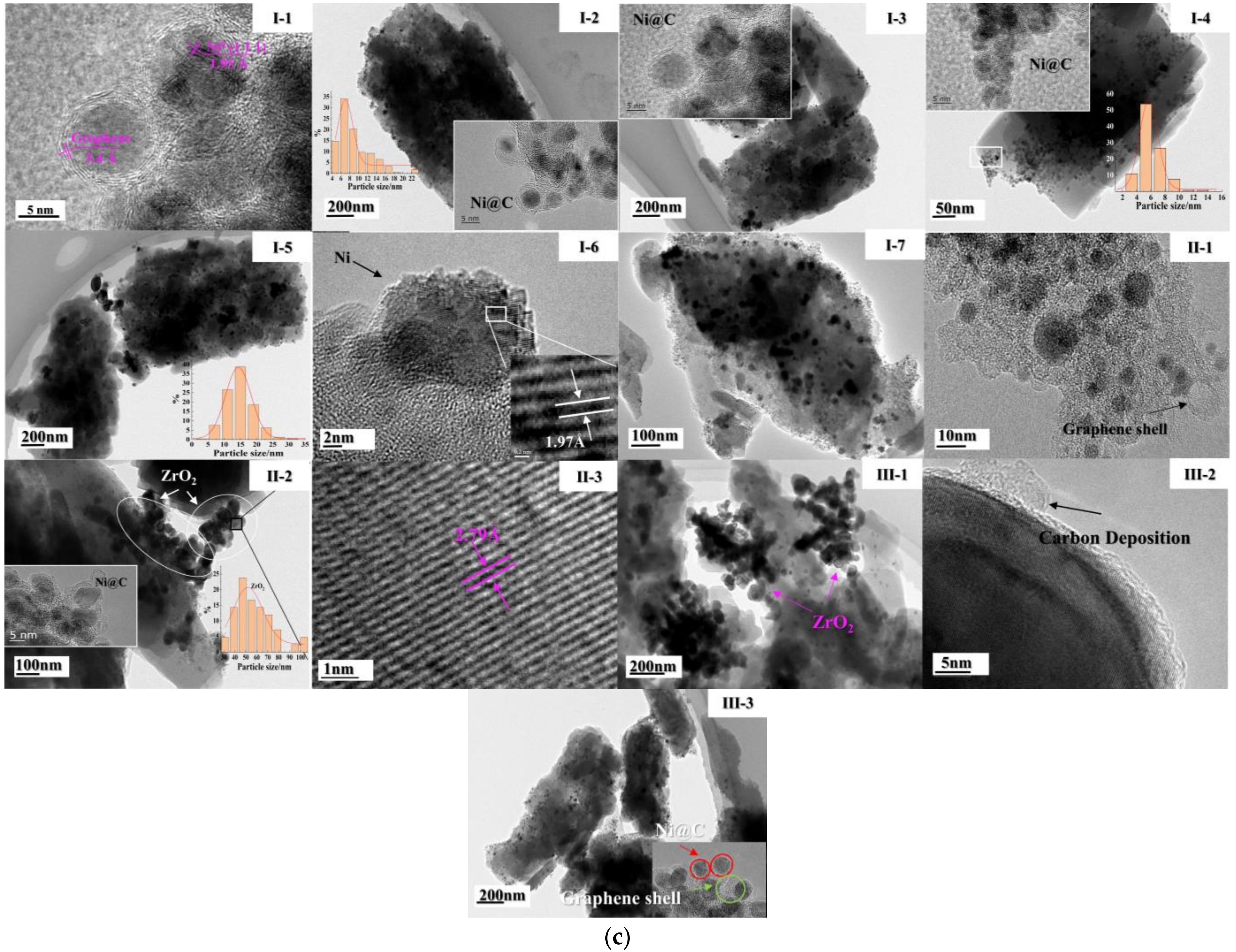
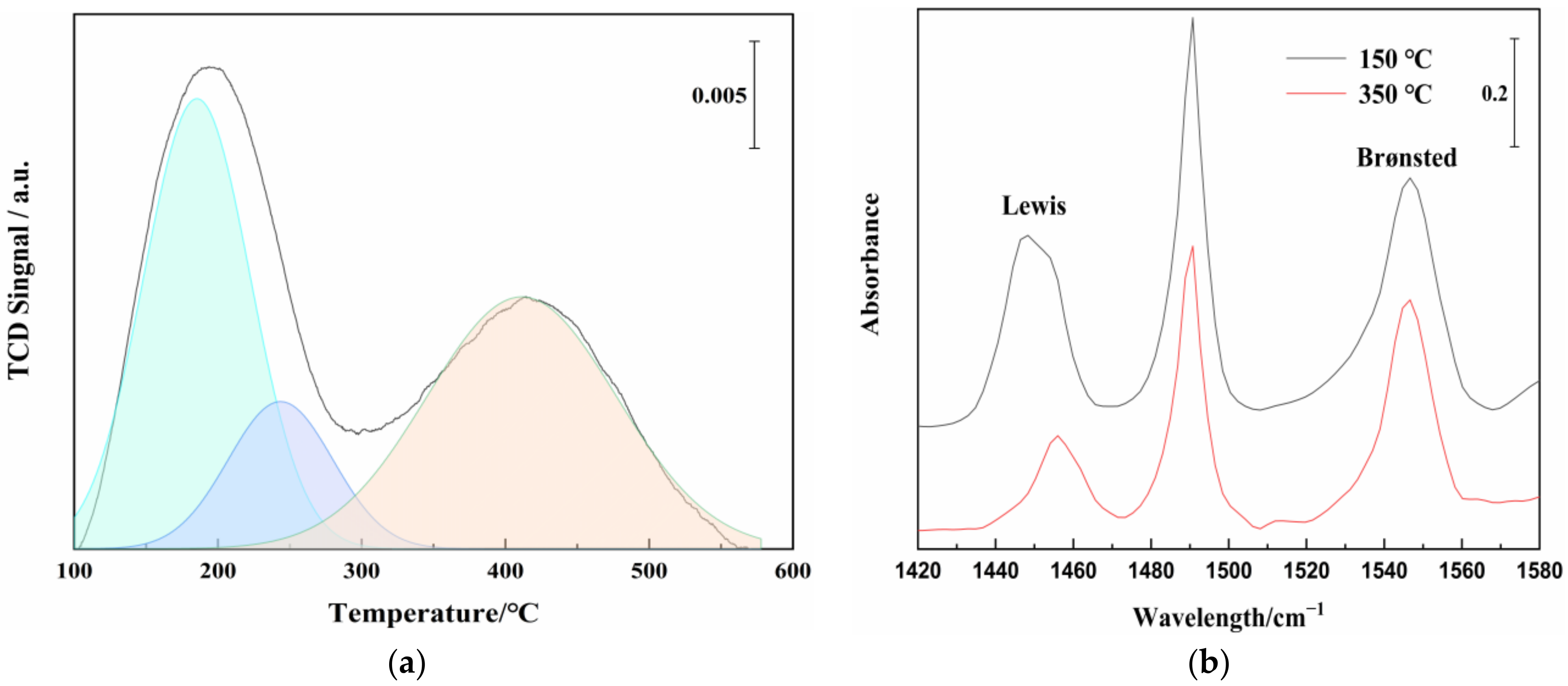
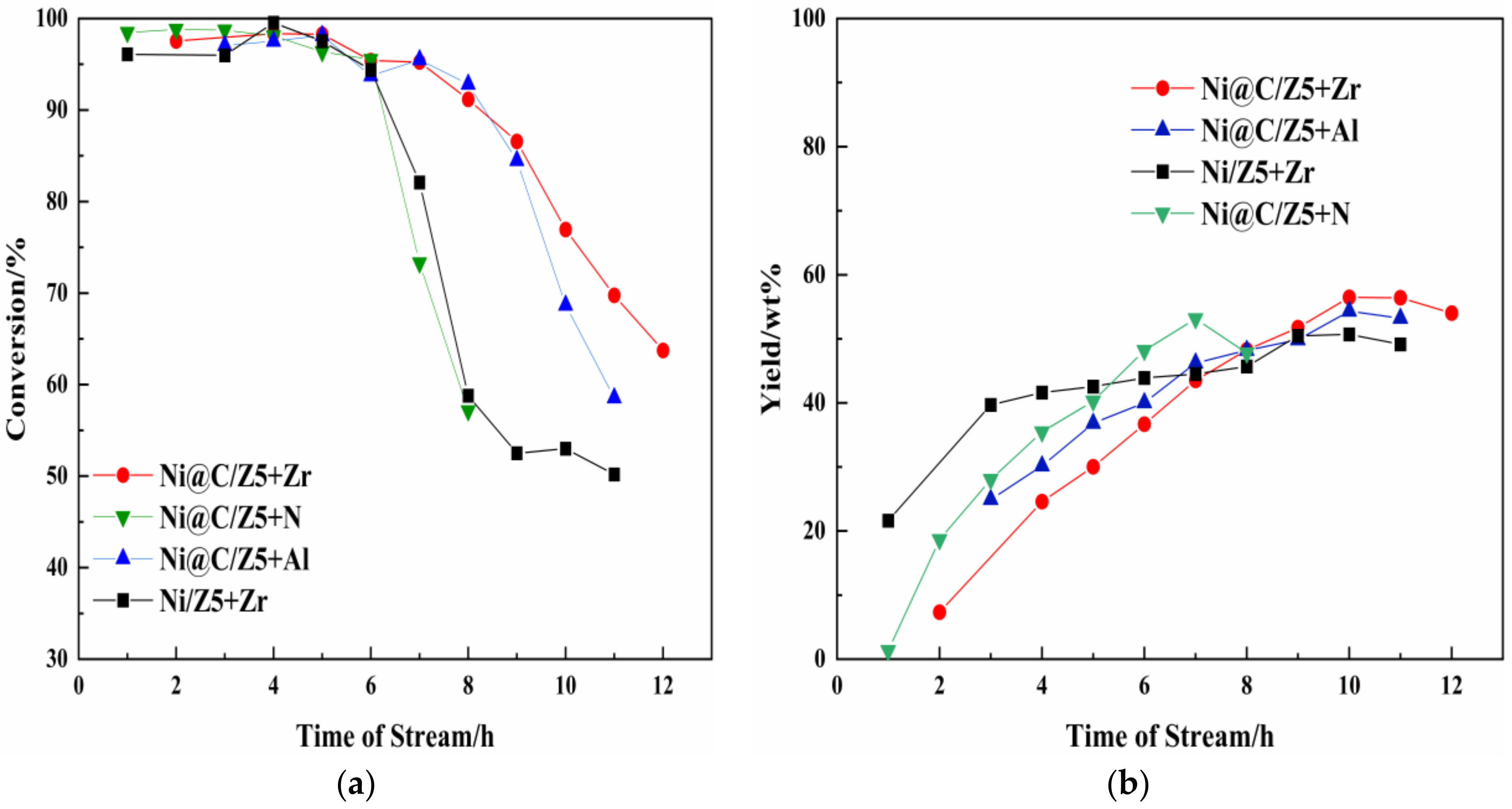
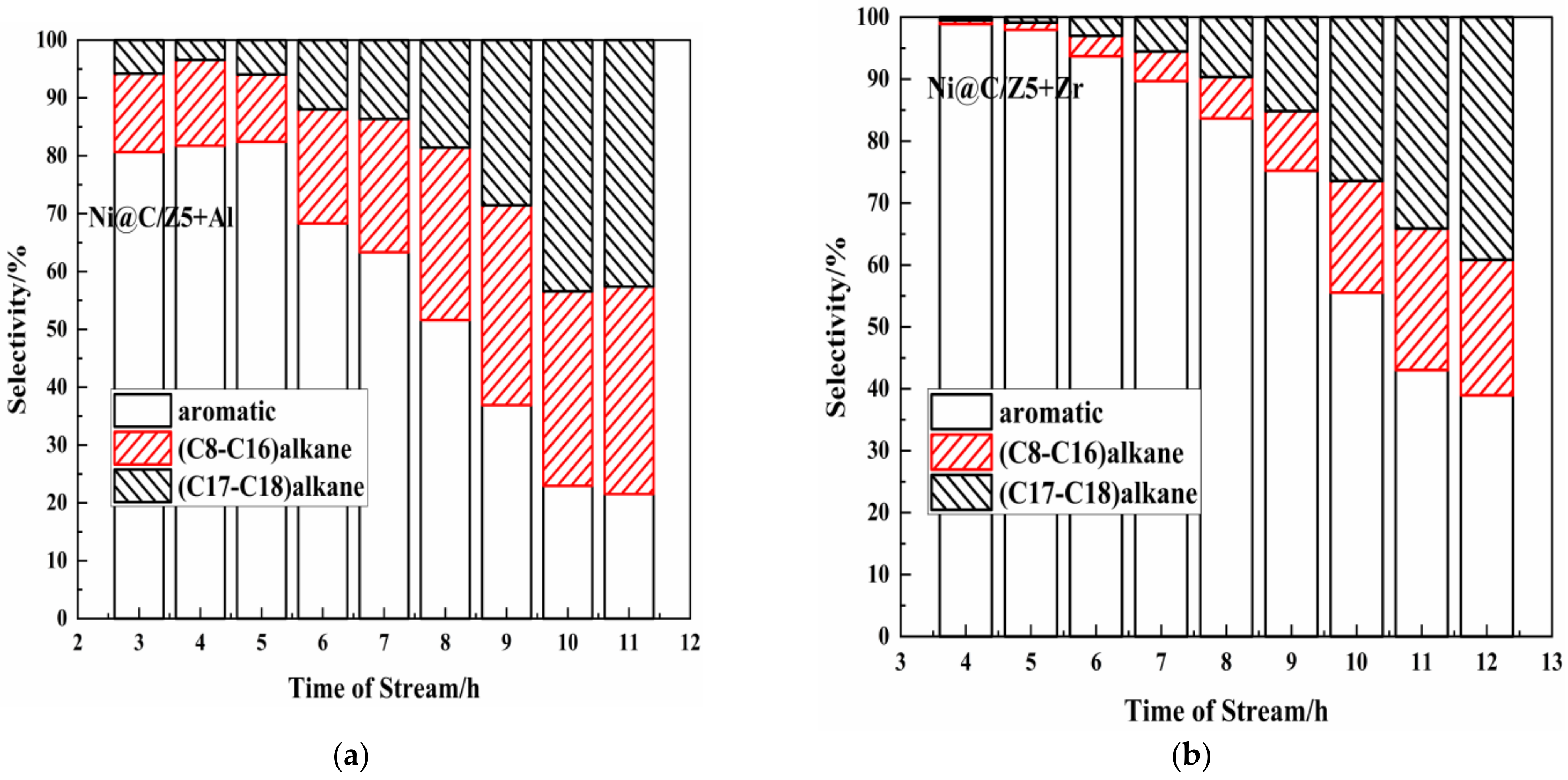
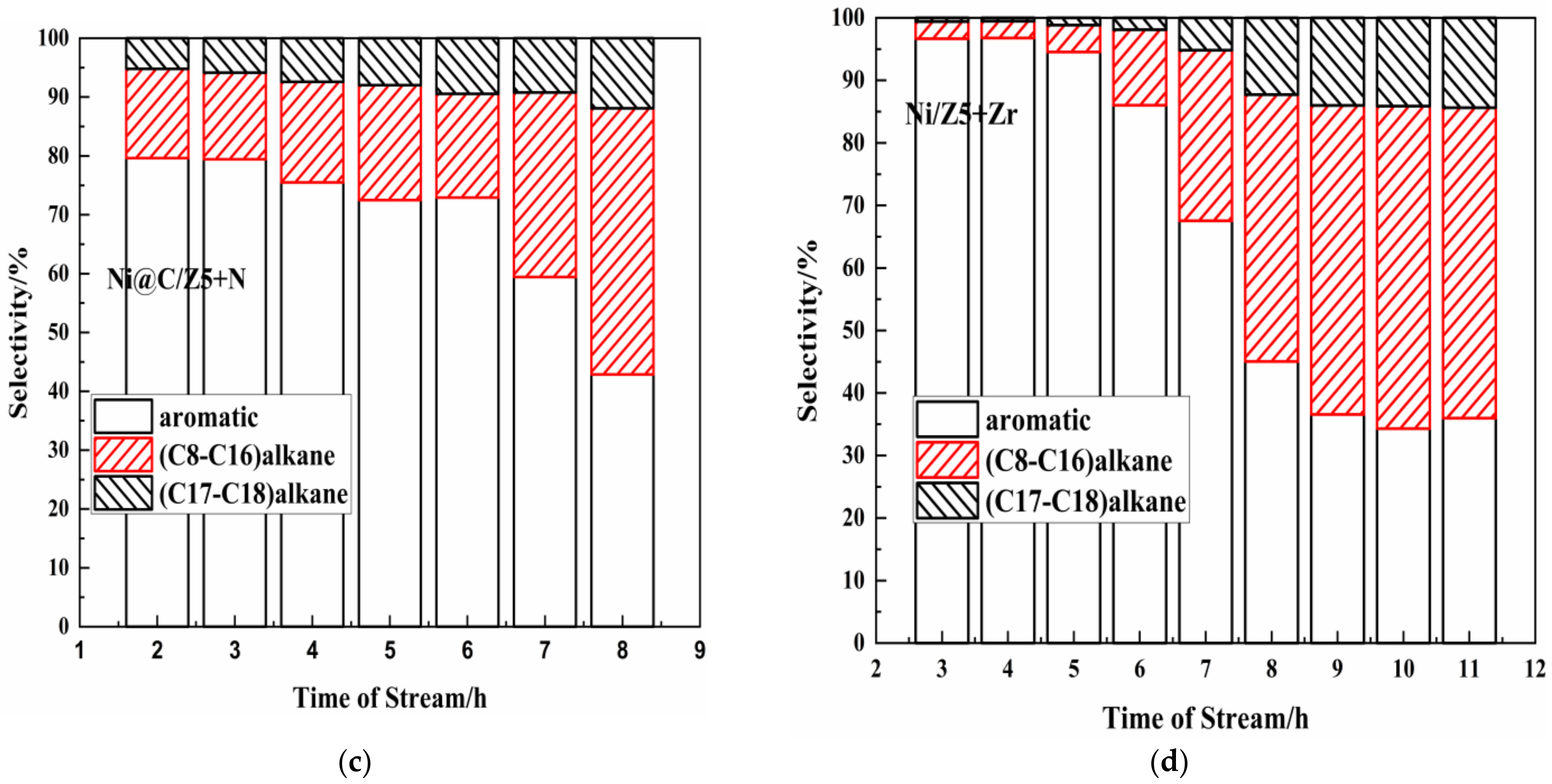



| Ni@C/Z5+N | Ni@C/Z5+Al | Ni@C/Z5+Zr | U-Ni@C/Z5+Zr | U-Ni@C/Z5+Zr after Air Calcination | Ni@C/Z5+Al after Pickling Test | Ni@C/Z5+Zr after Pickling Test | |
|---|---|---|---|---|---|---|---|
| C | 10.32 | 8.43 | 8.62 | 12.75 | 0.99 | 7.61 | 8.17 |
| O | 44 | 21.62 | 50.62 | 47.92 | 37.85 | 26.23 | 37.31 |
| Al | 2.65 | 32.06 | 2.68 | 2.28 | 3.40 | 30.39 | 3.17 |
| Si | 38.5 | 33.66 | 29.73 | 30.47 | 52.10 | 34.75 | 43.91 |
| Ni | 4.53 | 4.23 | 4.51 | 4.46 | 4.21 | 1.02 | 4.23 |
| Zr | - | - | 3.84 | 2.12 | 1.45 | - | 3.21 |
| Entry | Name | Formula | Grade | Company |
|---|---|---|---|---|
| 1 | Nickel nitrate hexahydrate | Ni(NO3)2·6H2O | ≥98% | Guangzhou Chemical Reagent Factory, (Guangzhou, China) |
| 2 | Oleic acid | CH3(CH2)7CH=CH(CH2)7COOH | AR | Guangzhou Chemical Reagent Factory, (Guangzhou, China) |
| 3 | Ethanol | C2H5OH | 99.5% | Shanghai Macklin Biochemical Co., Ltd., (Shanghai, China) |
| 4 | Sucrose | C12H22O11 | AR | Damao Chemical Regent Factory, (Tianjing, China) |
| 5 | Pseudo-boehmite | AlOOH·H2O | AR | Shanghai Macklin Biochemical Co., Ltd., (Shanghai, China) |
| 6 | Zirconium dioxide | ZrO2 | AR | Shanghai Macklin Biochemical Co., Ltd., (Shanghai, China) |
Publisher’s Note: MDPI stays neutral with regard to jurisdictional claims in published maps and institutional affiliations. |
© 2022 by the authors. Licensee MDPI, Basel, Switzerland. This article is an open access article distributed under the terms and conditions of the Creative Commons Attribution (CC BY) license (https://creativecommons.org/licenses/by/4.0/).
Share and Cite
Luo, W.; Zeng, Q.; Al-Haimi, A.A.N.M.; Li, M.; Yang, L.; Sun, Z.; Xing, S.; Fu, J.; Lv, P. Preparation and Performance of the Lipid Hydrodeoxygenation of a Nickel-Induced Graphene/HZSM-5 Catalyst. Catalysts 2022, 12, 627. https://doi.org/10.3390/catal12060627
Luo W, Zeng Q, Al-Haimi AANM, Li M, Yang L, Sun Z, Xing S, Fu J, Lv P. Preparation and Performance of the Lipid Hydrodeoxygenation of a Nickel-Induced Graphene/HZSM-5 Catalyst. Catalysts. 2022; 12(6):627. https://doi.org/10.3390/catal12060627
Chicago/Turabian StyleLuo, Wen, Qiongyao Zeng, Akram Ali Nasser Mansoor Al-Haimi, Ming Li, Lingmei Yang, Zhigang Sun, Shiyou Xing, Junying Fu, and Pengmei Lv. 2022. "Preparation and Performance of the Lipid Hydrodeoxygenation of a Nickel-Induced Graphene/HZSM-5 Catalyst" Catalysts 12, no. 6: 627. https://doi.org/10.3390/catal12060627
APA StyleLuo, W., Zeng, Q., Al-Haimi, A. A. N. M., Li, M., Yang, L., Sun, Z., Xing, S., Fu, J., & Lv, P. (2022). Preparation and Performance of the Lipid Hydrodeoxygenation of a Nickel-Induced Graphene/HZSM-5 Catalyst. Catalysts, 12(6), 627. https://doi.org/10.3390/catal12060627







